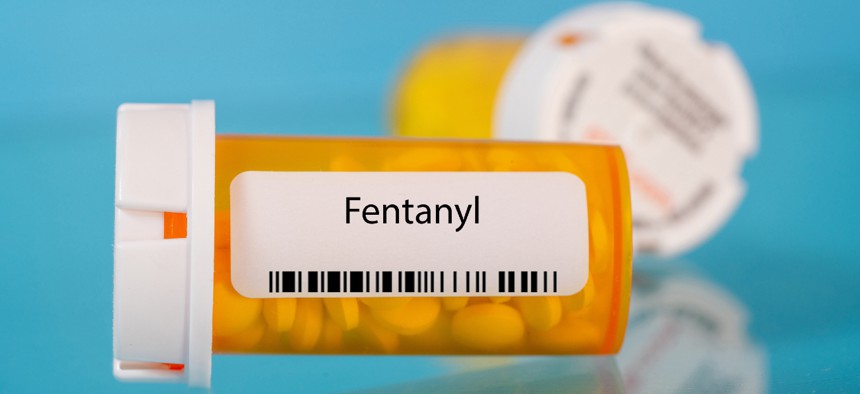Federal Agencies Detail Their Priorities in Battling the Fentanyl Epidemic

Customs and Border Protection seized more than 11,000 pounds of fentanyl in fiscal 2021, according to agency data. WLADIMIR BULGAR/SCIENCE PHOTO LIBRARY/Getty Images
Fentanyl seizures at the border have increased tenfold over the last three years.
With the United States experiencing a record 107,000 drug overdose deaths in fiscal 2021, nearly two-thirds stemming from synthetic opioids, federal agencies across government are devoting new resources to crack down on the epidemic.
Customs and Border Protection seized more than 11,000 pounds of fentanyl in fiscal 2021, according to agency data, more than doubling the total from the previous year and quadrupling it from fiscal 2019. CBP nearly doubled that total again in fiscal 2022, seizing more than 20,000 pounds. The Drug Enforcement Administration recently reported it seized 36 million lethal doses of fentanyl from May through September.
In recent years, most fentanyl entering the U.S. does so through the southern border after the requisite chemicals are shipped from east Asia to Mexico. Christopher Heck, an acting deputy assistant director at Homeland Security Investigations within the Homeland Security Department, said at the National Crime Prevention Council’s Fentanyl Summit on Wednesday that his component now has 93 offices in 56 countries working with local law enforcement to disrupt the fentanyl trade. HSI has hundreds of special agents working with host governments, Heck said, sharing intelligence and collaborating on investigations to "attack organized crimes at the manufacturing level." That has led the agency to seizing 800,000 pounds of "precursor chemicals” this year alone.
“Our objective is to stop the supply before it even arrives in Mexico,” Heck said.
When the chemicals make it through to the western hemisphere, HSI then works with its partners in Mexico to shut down the labs where fentanyl is typically manufactured. Finally, HSI collaborates with CBP to intercept the synthetic opioid at ports of entry.
CBP is responsible for screenings at ports of entry and inspecting the packages at the U.S. Postal Service’s international mail facilities. Pete Flores, executive assistant commissioner for CBP’s Office of Field Operations, told Congress earlier this year his agency has boosted its efforts to find and seize fentanyl by training all of its canine teams on opioid detection, providing field testing devices to CBP officers and having scientists on call 24 hours a day to review data.
President Trump in 2018 signed the Synthetics Trafficking and Overdose Prevention (STOP) Act into law, which aimed to require foreign countries to provide "advanced electronic data" on all international packages before they reached the United States. Congress passed the law as the opioid epidemic was ravaging communities throughout the country and international traffickers—primarily from China—were increasingly using the U.S. Postal Service to send synthetic opioids like fentanyl to American customers. While the law is still not fully implemented, it appears to have had a dramatic impact in shifting smuggling efforts away from the mail and toward the southern border.
Jon DeLena, DEA’s chief of public affairs, said at the summit on Wednesday that his agency is dealing with a threat on a scale it has never seen before. The drugs being chemical, rather than plant, based has made it easier for cartels to produce en masse. DEA has spearheaded efforts to follow the money trail to take down fentanyl production efforts. HSI, meanwhile, is now focusing its efforts on cryptocurrency, as Heck noted the “days of seeing hundreds and hundreds of thousands of dollars in a bag, as proceeds, are slowly slipping away.”
Derrick Brent, the deputy director of the U.S. Patent and Trademark Office, said his agency is collaborating with CBP, DEA, international partners and others to raise awareness of the dangers of counterfeit pharmaceuticals—which can sometimes contain dangerous synthetic opioids—and to drive down the demand for them. USPTO is working directly with its counterparts in Mexico to help authorities there identify counterfeit products.
Heck noted his agency is taking “huge precautions” to protect federal employees from potential fentanyl exposure, as even a small amount can be lethal. All feds potentially working in proximity to the drug, such as CBP officers at the mailing facilities, are provided with personal protective equipment. CBP is statutorily required to have Naloxone, or Narcan—a drug used to treat opioid overdose—available to all officers at risk of exposure to fentanyl. A 2019 inspector general’s report, however, found the agency had not always made it available and lacked a policy requiring it.
The House in July unanimously approved a bill (H.R. 5274) to require the CBP to issue “containment devices” to its front-line staff and train the workers on how to properly use them. The devices create a controlled, negative pressure environment to store the substances, which creates a safer environment for staff while also allowing for better preservation for investigative purposes. The Senate has yet to vote on the measure.
In his fiscal 2023 budget, President Biden requested $42.5 billion for research, prevention, treatment and recovery support services, which would mark a 7.5% increase. The White House last month announced $1.5 billion in grants from the Health and Human Services Department to support state and local efforts to address the opioid crisis.
Clarification: This story was updated to make clear HSI is the agency focusing on cryptocurrency investigations.






